 Local democracy in action. Congratulations to Doreen Residents Action Group for conducting a democratic survey to really test responses to Mathew Guy's "Melbourne Let's talk about the future" request for submissions. The following report is a summary of answers provided by residents of Doreen in response to a 17 question survey conducted in relation to the Melbourne Metropolitan Planning Strategy for the next 40 years.
Local democracy in action. Congratulations to Doreen Residents Action Group for conducting a democratic survey to really test responses to Mathew Guy's "Melbourne Let's talk about the future" request for submissions. The following report is a summary of answers provided by residents of Doreen in response to a 17 question survey conducted in relation to the Melbourne Metropolitan Planning Strategy for the next 40 years.
23rd March, 2013
Doreen Residents Action Group Incorporated, on behalf of the community of Doreen residents is appreciative of the opportunity to have an input into future planning of Melbourne, and trust that our views will be seriously considered as promised by you at the November 2012 meeting. We refer to the document “Melbourne Let’s talk about the future”.
Report on Survey re “Metropolitan Planning Strategy 2050”
The following report is a summary of answers provided by residents of Doreen in response to a 17 question survey conducted in relation to the Melbourne Metropolitan Planning Strategy for the next 40 years.
1a) People were asked what they liked most about living in Melbourne. The responses to this were quite varied and included the arts, diverse culture, beautiful city, parks and gardens, mild climate, great sporting events and cultural facilities, freedom, living in peace, the history, a good standard of living.
1b) The things people disliked most about living in Melbourne contained a more common theme. Some surveyed were upset regarding the demolition of Melbourne’s iconic buildings. Most residents surveyed conveyed their thoughts from the perspective of where they live, in Doreen, on the outer fringe of Melbourne where there is a huge lack of infrastructure, no train line, traffic, congested single lane roads, (i.e. Yan Yean Road and Plenty Road portion), the lack of Secondary Schools in the area, limited recreational facilities for youth, no police protection, were all very strong in the responses. Residents also worry that the character of Melbourne and the standard of living that we know today will change with the influx of immigration in the future being forecast. This includes future overdevelopment and overcrowding and a question of ‘will there be a guarantee of employment for all, existing and new residents?’
2. The features of Melbourne that people want protected and preserved are our current high standards of living, employment, no overcrowded suburbs or over developments, no inappropriate high rise buildings in residential areas, open spaces and parks and gardens, wetlands, green wedges, old historical buildings and landmarks.
3. People’s views on heritage buildings and homes were almost unanimous in that these should be protected and preserved for future generations. Comments included “we need to know the past to best know where we want to go” and “these buildings are a part of our history and identity”
4. One of Melbourne’s highly valued characteristics is its leafy green suburbs and open spaces/gardens and is coming under increasing threat. People were asked should we accept densification and build more on less or should we do something about the rate of growth. Most people responded that planned smaller allotments and houses were inevitable, but only in appropriate areas and provided they do not interfere with, or detract from existing neighbourhood character.
5. In regards to the rate of growth, there was a resounding ‘yes’ to reduce the rate of growth to be slow and controlled and to have more emphasis on skilled migrant intake. Other comments in answer to this question were “expand regional centres” and “we are so busy embracing diversity that we are in danger of neglecting our own core values” Surveys suggested residents were worried for their children and grand children if immigration is not slowed. Will their children and grand children have jobs in the future?
6. With the continuing growth of our outer suburbs, people were asked their thoughts on whether parts of Melbourne’s inner suburbs (with established infrastructure) could play a greater economic and housing role by replacing existing homes with apartment developments. There was a definitive response to this in that people replied that apartment building should be built on the older industrial areas and “not scattered among houses” because it destroys neighbourhood character and takes away established residents’ privacy and well being. The survey showed that residents worry about Developers building cheap apartments (they make money and don’t live there) “Don’t let the Developers build cheap concrete slab slums for homes.” “Housing Density in the inner suburbs should not increase because of Immigration.” “Melbourne already has a huge population in the inner suburbs.” Other comments indicate that if the inner suburbs became ‘densified’, current established infrastructure would not cope with huge increases in population. If apartments were built, they needed to be grouped not scattered. If replacing existing homes is a realistic approach, Planners must be aware of the possible increase in crime. “High rise/high density, tomorrow’s ghettos.”
7. The next question asked residents how they would feel if a multi storey apartment development was proposed or built in their street, opposite or next door.
Once again, there was a resounding answer in that nobody wants high rise buildings near them. Comments like “hate it”, “would definitely sell up” and “devastated”, “angry” were typical of answers to this question. At present there is no certainty anywhere in Melbourne that density development will not be proposed, not even semi-rural areas.
(Multi storey development proposals have already affected residents in the Doreen area. We know first hand that no-one wants them here in Doreen on the outskirts of Melbourne due to the support of 2000 objections from residents recently in a case that went to VCAT. Most objectors had no money to relocate as the bulk of the population in Doreen are either first home buyers or retirees. Fortunately, 2000 residents won their case at VCAT and this inappropriate development did not go ahead)
8. People were asked how can we accommodate the needs of changing populations in established suburbs and maintain what people love about their neighbourhoods.
The answer is “not to allow high rise buildings or sub-division of titles (splitting up blocks) or building too many units, as this creates road congestion and too many people living in small areas. Rather, build a whole new city away from Melbourne with proper infrastructure put in place first.
9. Densification is reported to adversely affect the health and well-being of residents. The question posed was how can we ensure a healthy and sustainable environment for future generations?
If densification adversely affects the health and well-being of residents, then limit the number of homes built in areas. Have controlled ‘Population Growth’.
Again residents responded to this question in relation to the Doreen area.
“Do not allow a ‘Big Australia’ with dense housing in outer suburbs. Protect Green Wedges and keep a strict limit on heights of houses to 9 metres maximum but still appropriately zone the 8 metre zone to the areas that require it, for example, Doreen– Laurimar. Over write the existing design guidelines for Doreen-Laurimar.”
Residents surveyed said there must be open spaces, parklands, playground areas and community facilities provided eg swimming centres, football ovals, tennis courts etc. It was also said that programs should be started to encourage young people to be pro-active in their communities.
Buildings could also be better designed, built and located. Expand the Regional areas before overdeveloping Melbourne. Another concern, was that densification breeds crime and drug activity.
10. Infrastructure upgrades – Residents filling out the survey were asked if they would be prepared to pay higher taxes or levies or go into deficit budgeting to finance these upgrades.
Most respondents would accept paying additional taxes or levies (not deficit budgeting) for these upgrades. However, the government must accept their responsibility in this area, by becoming more efficient and reducing their own wastage before taxing the population.
Another suggestion was that Government bonds be used to pay for infrastructure projects. Others said that infrastructure costs must go hand in hand with land sales.
11. Over recent years Melbourne’s Boundaries have been extended into the green wedge. Should there be a clearly defined and permanent outer boundary, marking where Melbourne stops and the urban areas begin?
There was an overwhelming ‘yes’ to this question.
Most residents of Doreen were shocked, angry, stressed and upset recently with the proposal of High Rise Buildings in the area. Many thought that we were protected from such things, living on the outer fringe of Melbourne an area we chose to live in and sold to us as “Country” living. If either the Council or Developer had told us, at the time of purchase, we agree that we would not have purchased blocks near the proposal and would have considered buying elsewhere.
12. Thinking about the next 30 to 40 years, what do you see as the most important issue/s for you, your children and grandchildren?
The most important issues that people see are:
The putting in place of appropriate infrastructure,
Safe areas for communities to live in,
Affordability of housing
Job availability,
Maintaining high standards of living,
Freedom and peace in the community.
The Government, Councils and Developers also have a responsibility to the community to be more transparent about changes to future housing and development projects. Reasonable notification must be given to communities facing housing changes, so people have a ‘choice’ about where they live and if they want to continue living there.
13. The new Advisory Committee has suggested Melbourne for the future be a city where residents can live and work locally. (A 20 minute City)
Most respondents said we should try and make Melbourne a 20 minute city, where people can live and work locally. In theory it sounds good, but a few said it would be impossible to achieve. It may be too costly at present to achieve this. Many residents suggested the money would be better spent fixing infrastructure problems in the outer suburbs first.
14. The new Advisory Committee has suggested a polycentric city (a city with many centres) linked to a network of regional cities throughout Victoria.
Most people thought the idea of a polycentric city linked to a network of regional cities in Victoria was a good one and should be explored further.
Some were worried that Melbourne Central as we know it today would lose its identity.
15. Employment and Innovation Clusters – most people thought this suggestion was a good one, however, a few thought it was already in place, e.g. Ringwood and Craigieburn. Others thought this should be considered when developing new areas. Some residents responded and said “The movement of people will be the problem.”
Others said “We must consider environmental and safety aspects of Industries, etc, away from residential.” Another comment was “Note that for Trades people, they can be asked to work anywhere in Melbourne, not just locally.”
Another said “Every new Development Cluster must have Private/Government Sectors working together to deliver the infrastructure simultaneously.”
16. It has been suggested that a new major city in Victoria be developed over time to cater for a population of over 1 million residents (or several million).
Some respondents thought this would be a great idea, but many emphasised that it must be planned correctly, and with proper infrastructure, including a new major Airport near the NSW border.
Others said we should further expand our current regional cities of Dandenong, Geelong, Ballarat and Bendigo with a ‘state of the art’ connecting transport system.
17. The overriding theme emerging from “Any Further Comments?” was that there must be a “catch up” on lack of infrastructure, which has occurred over the last 20 years and that this must not be allowed to re-occur in the future.
i.e. Proper infrastructure must accompany all new future developments.
This can only be achieved by the responsible Government Ministries (i.e. Planning, Transport and Education) working and consulting together in a timely manner.
It was also suggested that councils have the final say on what developments occur in their municipalities, as they know their own areas best. Developers should not have any recourse to VCAT if their permit application is rejected by council.
Residents must be given the opportunity to be involved earlier in the application and the planning process for developments in their neighbourhoods – not just be given
a 14 day window for objection at the end of the whole process.
Yours sincerely,
Brian Gloury
President
Doreen Residents Action Group
 Rally to “Stop the Great Wall of Frankston,” Saturday 13th May at 10.30 AM, Corner Wells St. and Kananook Creek Frankston. Planning Applications are at Frankston City Council for 14, 15 and 16 storey apartment blocks of up to 60 metres height on the beachside of Nepean Hwy, and only 200 metres from Frankston’s scenic beach. The towers would overshadow Kananook Creek, the beach, nearby homes, exacerbate wind tunnel effects and change the face of Frankston forever.
Rally to “Stop the Great Wall of Frankston,” Saturday 13th May at 10.30 AM, Corner Wells St. and Kananook Creek Frankston. Planning Applications are at Frankston City Council for 14, 15 and 16 storey apartment blocks of up to 60 metres height on the beachside of Nepean Hwy, and only 200 metres from Frankston’s scenic beach. The towers would overshadow Kananook Creek, the beach, nearby homes, exacerbate wind tunnel effects and change the face of Frankston forever. 
 Contents: Page 1 – Heritage Amendment Bill 2023; Victorian Departmental Restructure; Australian Architecture President Bells the Cat; Legislative Council Planning and Heritage Inquiry; Page 2 – Submissions Closing on World Heritage Management Plan for Royal Exhibition Building and Carlton Gardens; Speech to CROWAG, and April Forum; Level Crossing Removal FOI; War on Plastic – Clean Up Australia Day; Page 3 – South Australia’s Planning Minister Flags Change
Contents: Page 1 – Heritage Amendment Bill 2023; Victorian Departmental Restructure; Australian Architecture President Bells the Cat; Legislative Council Planning and Heritage Inquiry; Page 2 – Submissions Closing on World Heritage Management Plan for Royal Exhibition Building and Carlton Gardens; Speech to CROWAG, and April Forum; Level Crossing Removal FOI; War on Plastic – Clean Up Australia Day; Page 3 – South Australia’s Planning Minister Flags Change
 In this issue: 1.WELCOME TO 2023; 2.VCAT DELAYS; 3.STOP THE GREAT WALL OF FRANKSTON; 4.SUNBURY HIGH RISE TO GO TO VCAT; 5.KILMORE BUSHFIRE EVACUATION ISSUE; 6.BAD NEWS ON THE MORNINGTON PENINSULA; 7. KINGSWOOD GOLF COURSE; 8.477 SYDNEY RD. COBURG – BIKE SPACES, BUT NO CARS PLEASE; 9. PLANNING DEMOCRACY FACEBOOK PAGE; 10. WORLD HERITAGE MANAGEMENT PLAN OVERVIEW; 11.
In this issue: 1.WELCOME TO 2023; 2.VCAT DELAYS; 3.STOP THE GREAT WALL OF FRANKSTON; 4.SUNBURY HIGH RISE TO GO TO VCAT; 5.KILMORE BUSHFIRE EVACUATION ISSUE; 6.BAD NEWS ON THE MORNINGTON PENINSULA; 7. KINGSWOOD GOLF COURSE; 8.477 SYDNEY RD. COBURG – BIKE SPACES, BUT NO CARS PLEASE; 9. PLANNING DEMOCRACY FACEBOOK PAGE; 10. WORLD HERITAGE MANAGEMENT PLAN OVERVIEW; 11.
 Incredibly, Heritage Victoria's second formal Permit refusal to allow a developer's plans to build within the tree lined avenue approach to the former Willsmere Hospital is set to be reviewed by Heritage Council Victoria. (See
Incredibly, Heritage Victoria's second formal Permit refusal to allow a developer's plans to build within the tree lined avenue approach to the former Willsmere Hospital is set to be reviewed by Heritage Council Victoria. (See  The other day I retrieved a brochure with an illustration like this from my letter box. It was imploring me to take up residence in newly built apartments quite close to where I live. I guess that decor was supposed to sell the sterile looking place to me.
The other day I retrieved a brochure with an illustration like this from my letter box. It was imploring me to take up residence in newly built apartments quite close to where I live. I guess that decor was supposed to sell the sterile looking place to me. 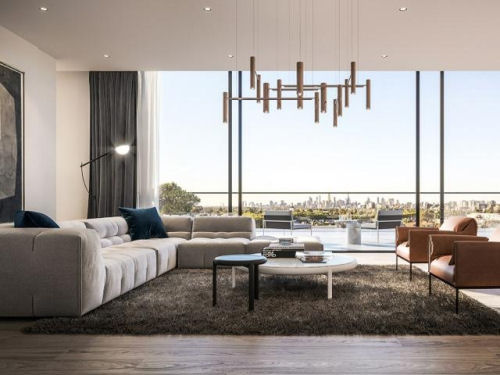


 There is his huge gap between what the people want and what politicians and their masters want.
There is his huge gap between what the people want and what politicians and their masters want.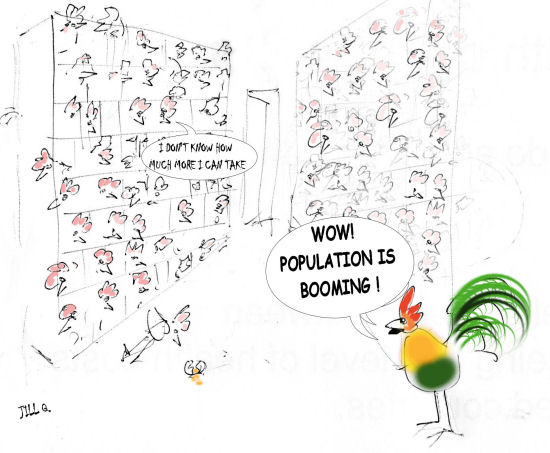 (Cartoon by Jill Quirk.)
(Cartoon by Jill Quirk.) The convenor was Richard Della Riva who just sat there and looked bored. His electoral office is in Vermont, so he would not know too many people in MacLeod.
The convenor was Richard Della Riva who just sat there and looked bored. His electoral office is in Vermont, so he would not know too many people in MacLeod.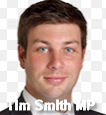 Tim Smith was then hammered by the rest who all complained each in their own way about the population growth, some gave mini-speeches from their seats. He used the excuse – not convincingly - that many of these questions were of a federal nature, again and again he asked people to make a written submission. You can make one at
Tim Smith was then hammered by the rest who all complained each in their own way about the population growth, some gave mini-speeches from their seats. He used the excuse – not convincingly - that many of these questions were of a federal nature, again and again he asked people to make a written submission. You can make one at  "As Sustainable Population Australia is an environmentally focused organization, we advocate policies that encourage human activity that is sustainable within finite natural limits and question the ongoing growth paradigm. Growth in the capital cities is reaching limits, whilst coastline development impacts fragile ecosystems. However, inland Australia is more subject to temperature extremes, water shortages and a lack of locational comparative advantage to sustain livelihoods. Within the context of an increasing climate emergency and peak fossil fuel energy, investment will be better spent on resilient communities and foreign aid rather than growth for growth's sake."
"As Sustainable Population Australia is an environmentally focused organization, we advocate policies that encourage human activity that is sustainable within finite natural limits and question the ongoing growth paradigm. Growth in the capital cities is reaching limits, whilst coastline development impacts fragile ecosystems. However, inland Australia is more subject to temperature extremes, water shortages and a lack of locational comparative advantage to sustain livelihoods. Within the context of an increasing climate emergency and peak fossil fuel energy, investment will be better spent on resilient communities and foreign aid rather than growth for growth's sake." Some extracts: "What sphinx of cement and aluminum bashed open their skulls and ate up their brains and imagination? [...] Moloch whose buildings are judgment! Moloch the vast stone of war! Moloch the stunned governments! Moloch whose mind is pure machinery! Moloch whose blood is running money! Moloch whose fingers are ten armies! Moloch whose breast is a cannibal dynamo! Moloch whose ear is a smoking tomb! Moloch whose eyes are a thousand blind windows! Moloch whose skyscrapers stand in the long streets like endless Jehovahs! Moloch whose factories dream and croak in the fog! Moloch whose smoke-stacks and antennae crown the cities! Moloch whose love is endless oil and stone! Moloch whose soul is electricity and banks! Moloch whose poverty is the specter of genius! Moloch whose fate is a cloud of sexless hydrogen! Moloch whose name is the Mind!" This is from "Howl" by Gregory Corso (1926-1997) was written in 1984. Full poem plus background at
Some extracts: "What sphinx of cement and aluminum bashed open their skulls and ate up their brains and imagination? [...] Moloch whose buildings are judgment! Moloch the vast stone of war! Moloch the stunned governments! Moloch whose mind is pure machinery! Moloch whose blood is running money! Moloch whose fingers are ten armies! Moloch whose breast is a cannibal dynamo! Moloch whose ear is a smoking tomb! Moloch whose eyes are a thousand blind windows! Moloch whose skyscrapers stand in the long streets like endless Jehovahs! Moloch whose factories dream and croak in the fog! Moloch whose smoke-stacks and antennae crown the cities! Moloch whose love is endless oil and stone! Moloch whose soul is electricity and banks! Moloch whose poverty is the specter of genius! Moloch whose fate is a cloud of sexless hydrogen! Moloch whose name is the Mind!" This is from "Howl" by Gregory Corso (1926-1997) was written in 1984. Full poem plus background at 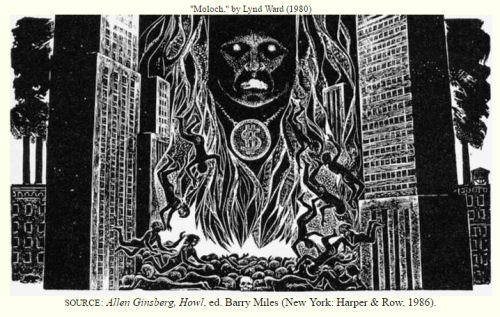
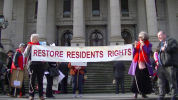 The Minister for Planning has publicly insisted [1] that Victoria has to fit 10 million people in Victoria with four more million in Melbourne and that that is the reason for the planning dictatorship he is trying to force on Victorians. If we did not 'have' to fit in millions more, no new plan would be 'needed'. Population numbers as a topic dominate the mainstream press,[2] but three residents' action groups in Planning Backlash - possibly trading on their marginal electorate status - reportedly held the rest to ransom for their presence at the Planning Backlash rally on the steps of parliament 8 June 2017. Their ransom was censorship of their fellow groups in a promise that no rally speakers would mention the role that population growth has in driving Plan Melbourne 2017-2050 and all the destruction it promises. Even though the Victorian Government has openly published several written policies for massive population growth, [3] the Yarra Residents' Coalition, Brunswick and Moreland groups of Planning Backlash have been identified as censoring debate about this on the very steps of Victoria's parliament.
The Minister for Planning has publicly insisted [1] that Victoria has to fit 10 million people in Victoria with four more million in Melbourne and that that is the reason for the planning dictatorship he is trying to force on Victorians. If we did not 'have' to fit in millions more, no new plan would be 'needed'. Population numbers as a topic dominate the mainstream press,[2] but three residents' action groups in Planning Backlash - possibly trading on their marginal electorate status - reportedly held the rest to ransom for their presence at the Planning Backlash rally on the steps of parliament 8 June 2017. Their ransom was censorship of their fellow groups in a promise that no rally speakers would mention the role that population growth has in driving Plan Melbourne 2017-2050 and all the destruction it promises. Even though the Victorian Government has openly published several written policies for massive population growth, [3] the Yarra Residents' Coalition, Brunswick and Moreland groups of Planning Backlash have been identified as censoring debate about this on the very steps of Victoria's parliament. The following article publishes an email sent by Tony Recsei, President of Save our Suburbs NSW, to SOS members and friends. Dated Thursday, 26 May 2016, it is a report on his attendance at a luncheon organised by the Greater Sydney Commission (GSC) in Paramatta.
The following article publishes an email sent by Tony Recsei, President of Save our Suburbs NSW, to SOS members and friends. Dated Thursday, 26 May 2016, it is a report on his attendance at a luncheon organised by the Greater Sydney Commission (GSC) in Paramatta. 
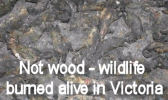 Video inside. This article is about the effects of 390,000 ha of native vegetation targeted to be burned every year in Victoria, Australia's most cleared state. The video inside this article documents how vast numbers of Australian wildlife are burned alive in scientifically dubious prescribed burns, mandated by the Victorian Government. It asks whether the cruel and avoidable fate of many wildlife in prescribed burns is really protecting human lives and assets or merely a way of meeting an arbitrary target. Others would be much harsher and say that this may be a calculated strategy to rid the state of wildlife in addition to an apparently deliberate failure to cooperate with wildlife activists in making easily protected wildlife corridors to connect viable habitat.[1]
Video inside. This article is about the effects of 390,000 ha of native vegetation targeted to be burned every year in Victoria, Australia's most cleared state. The video inside this article documents how vast numbers of Australian wildlife are burned alive in scientifically dubious prescribed burns, mandated by the Victorian Government. It asks whether the cruel and avoidable fate of many wildlife in prescribed burns is really protecting human lives and assets or merely a way of meeting an arbitrary target. Others would be much harsher and say that this may be a calculated strategy to rid the state of wildlife in addition to an apparently deliberate failure to cooperate with wildlife activists in making easily protected wildlife corridors to connect viable habitat.[1]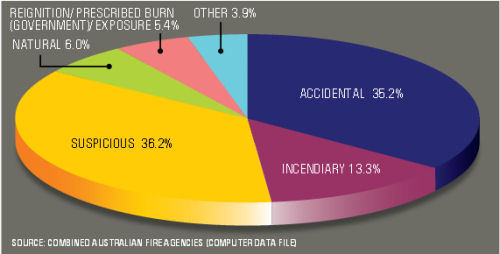
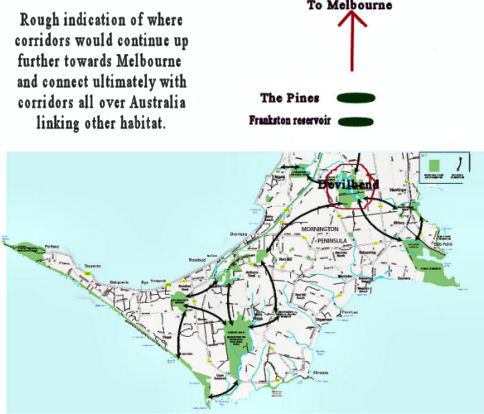

 Item 6.3, MCC Futures Committee Meeting on 10 December 2013: "Council’s submission should state ‘up front’ that it opposes the East West Link project. This inner urban freeway project will undermine, erode and destroy part of Royal Park being a special place of state and metropolitan significance, as well as a signature feature of Melbourne’s renowned network of large parks and gardens. These much valued public assets are integral to our city’s liveability and distinctiveness. We are not being asked by government if we want this project – we are being told we must have it noting that there isn’t a week that goes by that the evidence against this project grows and grows." Roz Hansen
Item 6.3, MCC Futures Committee Meeting on 10 December 2013: "Council’s submission should state ‘up front’ that it opposes the East West Link project. This inner urban freeway project will undermine, erode and destroy part of Royal Park being a special place of state and metropolitan significance, as well as a signature feature of Melbourne’s renowned network of large parks and gardens. These much valued public assets are integral to our city’s liveability and distinctiveness. We are not being asked by government if we want this project – we are being told we must have it noting that there isn’t a week that goes by that the evidence against this project grows and grows." Roz Hansen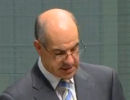

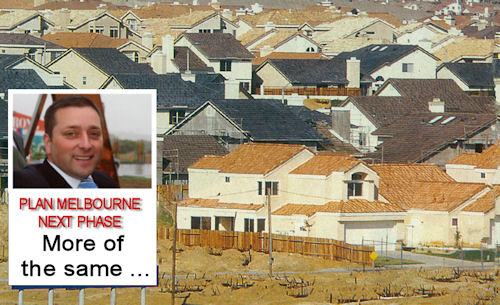
 Sustainable Population Australia, Green Wedges Coalition, Protectors of Public Lands Victoria and Planning Backlash are four of the peak planning and environmental groups that have produced a Sustainable Population Charter for Victoria because the government seems unable to do so. It recommends that net overseas migration be reduced from the recent 232,000 immigrants in a year to 70,000 net per annum. See
Sustainable Population Australia, Green Wedges Coalition, Protectors of Public Lands Victoria and Planning Backlash are four of the peak planning and environmental groups that have produced a Sustainable Population Charter for Victoria because the government seems unable to do so. It recommends that net overseas migration be reduced from the recent 232,000 immigrants in a year to 70,000 net per annum. See 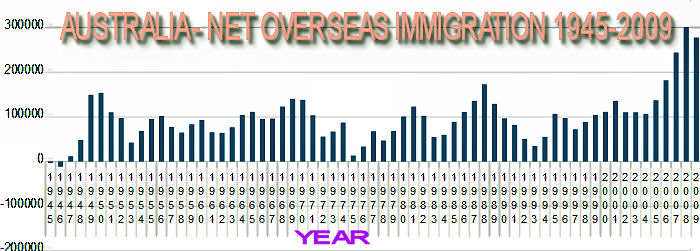


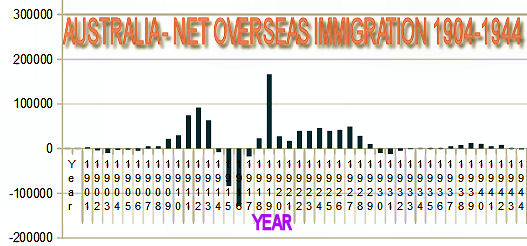
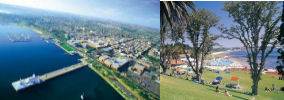 What does the G21Geelong Region Plan mean for Geelong? There are already huge developments everywhere including 2000 blocks in Highton, extensive new subdivisions on the Bellarine Peninsula and in Fyansford where a 1000 house development was announced this week. It is also rumoured that Barwon Water can barely cope with the rapid and huge development. The consquences will be traffic congestion, long hospital waiting lists, pollution, and inadequate rail transport from Geelong to Melbourne.
What does the G21Geelong Region Plan mean for Geelong? There are already huge developments everywhere including 2000 blocks in Highton, extensive new subdivisions on the Bellarine Peninsula and in Fyansford where a 1000 house development was announced this week. It is also rumoured that Barwon Water can barely cope with the rapid and huge development. The consquences will be traffic congestion, long hospital waiting lists, pollution, and inadequate rail transport from Geelong to Melbourne.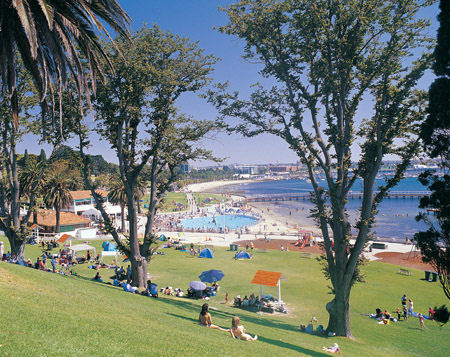 The G21Geelong Region Plan – a ‘sustainable growth strategy’ has big plans for Geelong and environs. The areas covered by the plan are Colac, Golden Plains, Greater Geelong, Queenscliffe and Surf Coast.
The G21Geelong Region Plan – a ‘sustainable growth strategy’ has big plans for Geelong and environs. The areas covered by the plan are Colac, Golden Plains, Greater Geelong, Queenscliffe and Surf Coast. Local democracy in action. Congratulations to Doreen Residents Action Group for conducting a democratic survey to really test responses to Mathew Guy's "Melbourne Let's talk about the future" request for submissions. The following report is a summary of answers provided by residents of Doreen in response to a 17 question survey conducted in relation to the Melbourne Metropolitan Planning Strategy for the next 40 years.
Local democracy in action. Congratulations to Doreen Residents Action Group for conducting a democratic survey to really test responses to Mathew Guy's "Melbourne Let's talk about the future" request for submissions. The following report is a summary of answers provided by residents of Doreen in response to a 17 question survey conducted in relation to the Melbourne Metropolitan Planning Strategy for the next 40 years. We urge you to write a submission to Planning Minister, Matthew Guy’s, “Melbourne, let’s talk about the future”. Submissions close: 28th March. Go to:
We urge you to write a submission to Planning Minister, Matthew Guy’s, “Melbourne, let’s talk about the future”. Submissions close: 28th March. Go to: 
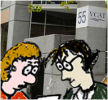 As a residents’ group which deals with planning procedures, Malvern East Group (MEG) finds that VCAT fails its own mission statements of being a low cost, accessible, efficient and independent tribunal delivering high quality dispute resolution. The institution of draconian fees now dramatically highlights this disconnect.
As a residents’ group which deals with planning procedures, Malvern East Group (MEG) finds that VCAT fails its own mission statements of being a low cost, accessible, efficient and independent tribunal delivering high quality dispute resolution. The institution of draconian fees now dramatically highlights this disconnect.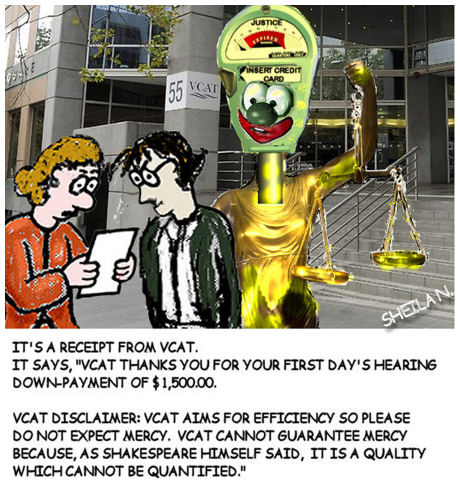
 Sustainable Population Australia takes the State of the Environment report 2008 as a warning of the unsustainable path that Victoria is on as the government recklessly engineers its population at a rate about twice the level it would naturally be at present. This state government and its predecessors have actively encouraged population growth through the artificial means of seeking increasing numbers of migrants from overseas to settle in Victoria, using the website
Sustainable Population Australia takes the State of the Environment report 2008 as a warning of the unsustainable path that Victoria is on as the government recklessly engineers its population at a rate about twice the level it would naturally be at present. This state government and its predecessors have actively encouraged population growth through the artificial means of seeking increasing numbers of migrants from overseas to settle in Victoria, using the website 
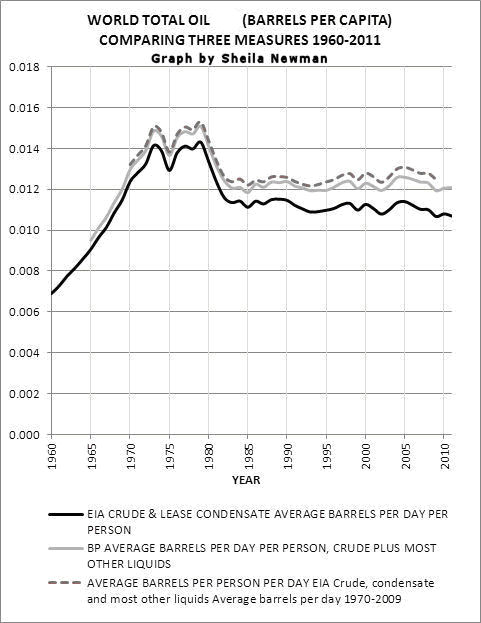
 In her submission to the Victorian State Department of Planning and Community Services, Julianne Bell, Secretary of
In her submission to the Victorian State Department of Planning and Community Services, Julianne Bell, Secretary of 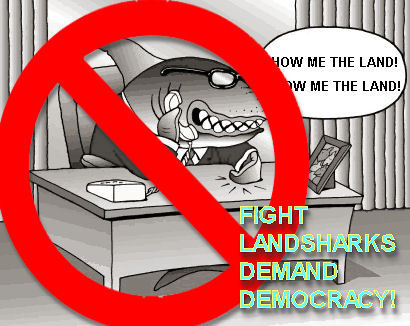
 Planning Backlash Inc, a coalition of 250 resident groups across city, coast and country, is astonished at the complexity of the proposals for major changes to Melbourne and her Green Wedges and the limited time to understand it and make submissions. Coalition members are disappointed that there has been no thought given by Government to run public sessions to explain the changes. As a result the vast majority of people don’t know what is happening and have been given no opportunity to find out.
Planning Backlash Inc, a coalition of 250 resident groups across city, coast and country, is astonished at the complexity of the proposals for major changes to Melbourne and her Green Wedges and the limited time to understand it and make submissions. Coalition members are disappointed that there has been no thought given by Government to run public sessions to explain the changes. As a result the vast majority of people don’t know what is happening and have been given no opportunity to find out.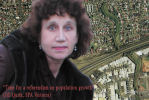 The government needs to listen to the electorate. Consecutive public community polls have shown that Australians are very concerned about the ongoing rapid rate of population growth and density of development, food security, and social disorganisation in poorly serviced new suburbs.
The government needs to listen to the electorate. Consecutive public community polls have shown that Australians are very concerned about the ongoing rapid rate of population growth and density of development, food security, and social disorganisation in poorly serviced new suburbs.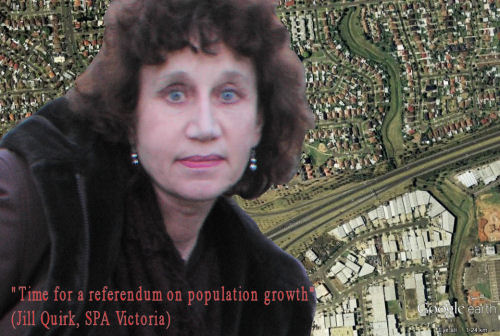
 Culex molestus is thought to have been introduced into southern Australia in the 1940s, hitching a ride into the country with travelling American military personnel. The species is known in other countries for the spread of West Nile virus. Since the 1940s the mosquito has been found in all states except Queensland and the Northern Territory. Where exactly the mosquito came from before arriving in Australia is still a mystery but it is well known from cities in the US and Europe. The mosquito infamously made a meal of Londoners sleeping in the Underground during the Blitz and is often commonly referred to as the London Underground Mosquito. The culex species, although not necessarily Culex molestus, has been implicated in the spread of diverse diseases which include Eastern Equine Encephalitis, Japanese Encephalitis Virus, St. Louis Encephalitis, and Western Equine Encephalitis.
Culex molestus is thought to have been introduced into southern Australia in the 1940s, hitching a ride into the country with travelling American military personnel. The species is known in other countries for the spread of West Nile virus. Since the 1940s the mosquito has been found in all states except Queensland and the Northern Territory. Where exactly the mosquito came from before arriving in Australia is still a mystery but it is well known from cities in the US and Europe. The mosquito infamously made a meal of Londoners sleeping in the Underground during the Blitz and is often commonly referred to as the London Underground Mosquito. The culex species, although not necessarily Culex molestus, has been implicated in the spread of diverse diseases which include Eastern Equine Encephalitis, Japanese Encephalitis Virus, St. Louis Encephalitis, and Western Equine Encephalitis.

 This superb document establishes a history of concerted public demand for protection of the green wedges and a host of reasons for that public opposition to Matthew Guy's six new suburbs. It represents more than 80 groups of Victorians - (Ed. Candobetter.) "The whole rationale for extending the Urban Growth Boundary is to accommodate the unprecedented flood of population to Victoria. PPL VIC considers that the extension of the Urban Growth Boundary is really the thin end of the wedge. As there are no plans to stop the present high rate of population growth (mostly from immigration) the process of loss of Green Wedges and agricultural land is endless. There will be another extension when the proposed boundaries are seen to be filling up. The Government must abandon the Green Wedge land grab as destructive of the environment, a threat to wildlife, including endangered species, and as a major contributor to Green House Gas Emissions. Around the urban fringe we have a concentration of some of the most endangered eco- systems in Australia..." Julianne Bell, Protectors of Public Land, VictoriaJulianne Bell, Protectors of Public Land, Victoria.
This superb document establishes a history of concerted public demand for protection of the green wedges and a host of reasons for that public opposition to Matthew Guy's six new suburbs. It represents more than 80 groups of Victorians - (Ed. Candobetter.) "The whole rationale for extending the Urban Growth Boundary is to accommodate the unprecedented flood of population to Victoria. PPL VIC considers that the extension of the Urban Growth Boundary is really the thin end of the wedge. As there are no plans to stop the present high rate of population growth (mostly from immigration) the process of loss of Green Wedges and agricultural land is endless. There will be another extension when the proposed boundaries are seen to be filling up. The Government must abandon the Green Wedge land grab as destructive of the environment, a threat to wildlife, including endangered species, and as a major contributor to Green House Gas Emissions. Around the urban fringe we have a concentration of some of the most endangered eco- systems in Australia..." Julianne Bell, Protectors of Public Land, VictoriaJulianne Bell, Protectors of Public Land, Victoria.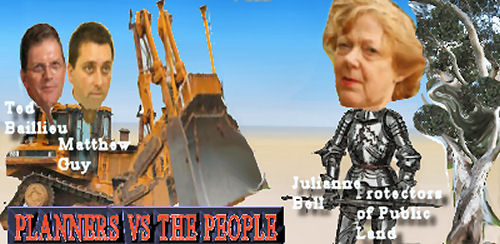
Recent comments